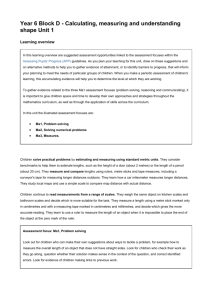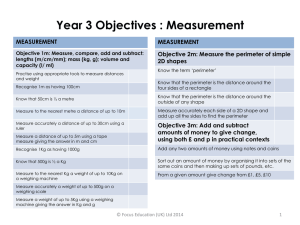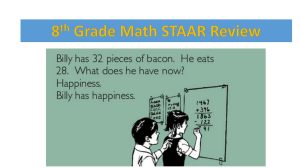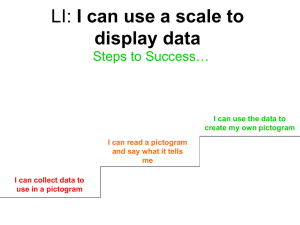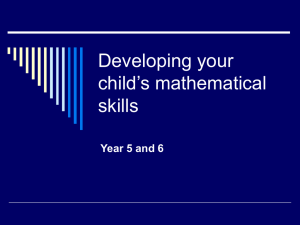Year 1 Block D - Calculating, measuring and understanding shape
advertisement
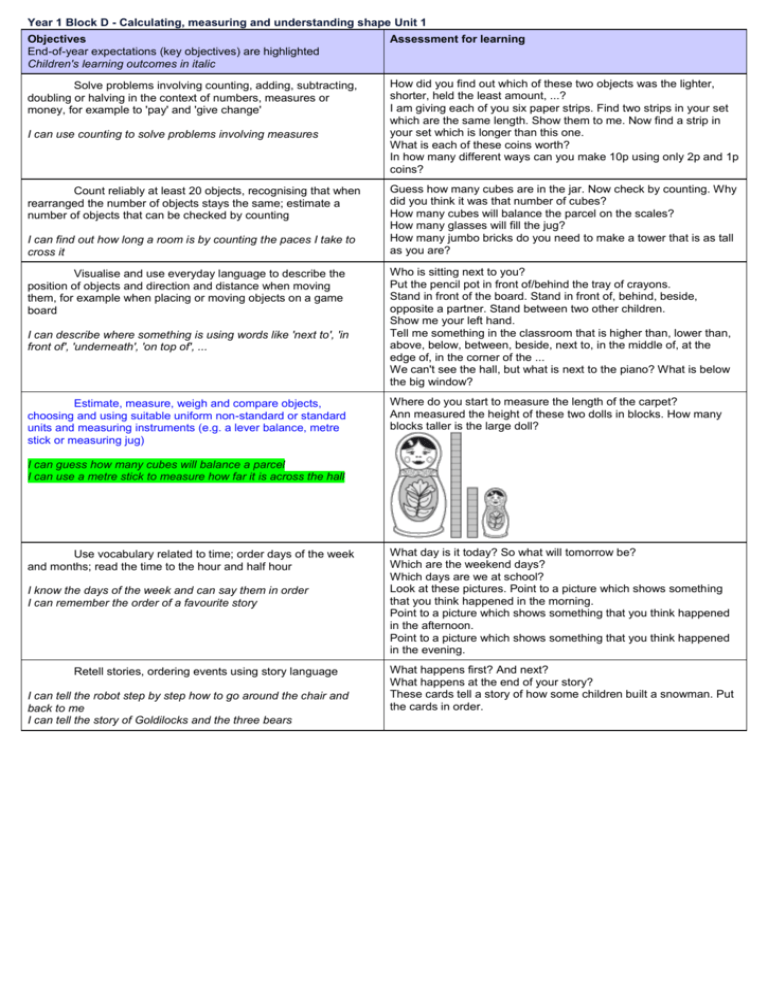
Year 1 Block D - Calculating, measuring and understanding shape Unit 1 Objectives End-of-year expectations (key objectives) are highlighted Children's learning outcomes in italic Assessment for learning Solve problems involving counting, adding, subtracting, doubling or halving in the context of numbers, measures or money, for example to 'pay' and 'give change' How did you find out which of these two objects was the lighter, shorter, held the least amount, ...? I am giving each of you six paper strips. Find two strips in your set which are the same length. Show them to me. Now find a strip in your set which is longer than this one. What is each of these coins worth? In how many different ways can you make 10p using only 2p and 1p coins? I can use counting to solve problems involving measures Count reliably at least 20 objects, recognising that when rearranged the number of objects stays the same; estimate a number of objects that can be checked by counting I can find out how long a room is by counting the paces I take to cross it Visualise and use everyday language to describe the position of objects and direction and distance when moving them, for example when placing or moving objects on a game board I can describe where something is using words like 'next to', 'in front of', 'underneath', 'on top of', ... Estimate, measure, weigh and compare objects, choosing and using suitable uniform non-standard or standard units and measuring instruments (e.g. a lever balance, metre stick or measuring jug) Guess how many cubes are in the jar. Now check by counting. Why did you think it was that number of cubes? How many cubes will balance the parcel on the scales? How many glasses will fill the jug? How many jumbo bricks do you need to make a tower that is as tall as you are? Who is sitting next to you? Put the pencil pot in front of/behind the tray of crayons. Stand in front of the board. Stand in front of, behind, beside, opposite a partner. Stand between two other children. Show me your left hand. Tell me something in the classroom that is higher than, lower than, above, below, between, beside, next to, in the middle of, at the edge of, in the corner of the ... We can't see the hall, but what is next to the piano? What is below the big window? Where do you start to measure the length of the carpet? Ann measured the height of these two dolls in blocks. How many blocks taller is the large doll? I can guess how many cubes will balance a parcel I can use a metre stick to measure how far it is across the hall Use vocabulary related to time; order days of the week and months; read the time to the hour and half hour I know the days of the week and can say them in order I can remember the order of a favourite story Retell stories, ordering events using story language I can tell the robot step by step how to go around the chair and back to me I can tell the story of Goldilocks and the three bears What day is it today? So what will tomorrow be? Which are the weekend days? Which days are we at school? Look at these pictures. Point to a picture which shows something that you think happened in the morning. Point to a picture which shows something that you think happened in the afternoon. Point to a picture which shows something that you think happened in the evening. What happens first? And next? What happens at the end of your story? These cards tell a story of how some children built a snowman. Put the cards in order. Year 2 Block D - Calculating, measuring and understanding shape Unit 1 Objectives Assessment for learning End-of-year expectations (key objectives) are highlighted Children's learning outcomes in italic Solve problems involving addition, subtraction, multiplication or division in contexts of numbers, measures or pounds and pence I can decide what calculation to do to solve a problem Add or subtract mentally a one-digit number or a multiple of 10 to or from any two-digit number; use practical and informal written methods to add and subtract two-digit numbers I can add and subtract some numbers in my head Solve these problems. What calculations are needed? How did you decide? Mina and Ben play a game. Mina scores 70 points. Ben scores 42 points. How many more points does Mina score than Ben? I think of a number then halve it. The answer is 9. What was my number? Rosie spent 48p. Suzy spent 36p more than Rosie. How much did Suzy spend? How much money is in the hand? Look at the number line. It shows the sum that Fred did. Which of these sums did Fred do? 5 7 2 14 5 6 3 14 5 5 4 14 5 8 1 14 What is 34 8? What number facts might you use to help you work this out? What do you need to add to 34 to get to the next multiple of 10? How might you partition 8 to help you? Find the answer for each of these. Explain how you worked out your answers. 58 9 35 40 72 - 8 Find the missing number. 1 5 35 Read the numbered divisions on a scale, and interpret the divisions between them (e.g. on a scale from 0 to 25 with intervals of 1 shown but only the divisions 0, 5, 10, 15 and 20 numbered); use a ruler to draw and measure lines to the nearest centimetre I can read numbers on a scale [Point to 65cm on a metre stick marked in centimetres and numbered in tens.] What measurement is this? [Point to half a litre on a 1 litre measuring jug.] What measurement is this? Estimate, compare and measure lengths, weights and capacities, choosing and using standard units (m, cm, kg, litre) and suitable measuring instruments Measure these two lines. How much longer is line A than line B? I can use a metre rule to mark out 1 metre I can measure out a litre of water Suggest things that: are longer than 1m are shorter than 10cm are lighter than 1kg hold more than 1 litre Show me where the 2 metre mark is on the tape measure. And the 3 metre mark? How could you mark out 2 metres using a metre stick? How could you find out how much water this bucket will hold? If you have a half-kilogram weight, how could you use it to weigh out a kilogram of sand to go in this bucket? Use units of time (seconds, minutes, hours, days) and know the relationships between them; read the time to the quarter hour; identify time intervals, including those that cross the hour I can estimate how long an activity might take, then check using a timer I can tell the time when it is something o'clock or half past the hour Follow and give instructions involving position, direction and movement. What takes about 10 seconds? 1 minute? 1 hour? Look at these pictures of different events. [Point to a picture.] How long would this activity take? Use this seconds timer. Time me while I walk across the room and back again. How long did I take? How many minutes are there in 1 hour? It is half past 4. How many minutes have passed since 4 o'clock? What is the time on this clock? What time was it 2 hours ago? The tick is in square B5. Follow my instructions. Draw a cross in square D2. Draw a circle in square E4. Draw a triangle in square A5. I can follow and give instructions to mark a position on a grid Now tell me where to put a cross, a circle and a triangle. Listen to others in class, ask relevant questions and follow instructions I can listen to others and ask them questions about their work Listen while these children explain how they tackled a problem. What questions would you like to ask them? Year 3 Block D - Calculating, measuring and understanding shape Unit 1 Objectives Assessment for learning End-of-year expectations (key objectives) are highlighted Children's learning outcomes in italic Solve one-step and two-step problems involving numbers, money or measures, including time, choosing and carrying out appropriate calculations I can work out what calculations to do to solve a word problem that involves measurements Add or subtract mentally combinations of one-digit and two-digit numbers I can add or subtract a one-digit number to or from a two-digit number I can add or subtract a multiple of 10 to or from a two-digit number What is the first calculation you will do to solve this problem? What does this answer tell you? What will you do next? Look at this problem. Ella buys a 6p lolly. She pays with a 50p piece. How much change does she get? Which calculation will you do to solve this problem? 50 6 50 – 6 50 6 50 6 How did you choose the correct calculation? What unit is the answer in? Look at this problem. Explain how to work it out. Wilf has 68p in his money bank. He adds another 5p. How much is in his money bank now? What is the missing number? What calculation is represented on the number line? Sam adds a 50g weight to scales containing 45g. What is the weight on the scales now? , Find unit fractions of numbers and quantities (e.g. and of 12 litres) I can find 1 or , of a measurement Read and record the vocabulary of position, direction and movement, using the four compass directions to describe movement about a grid I can describe the position of a square on a grid I can use the compass points (north, south, east and west) to describe a direction Know the relationships between kilometres and metres, metres and centimetres, kilograms and grams, litres and millilitres; choose and use appropriate units to estimate, measure and record measurements I know how many grams are the same as 1kg I can estimate whether an object is lighter than a 100g weight Read, to the nearest division and half-division, scales that are numbered or partially numbered; use the information to measure and draw to a suitable degree of accuracy I can read scales to the nearest division or half-division Read the time on a 12-hour digital clock and to the nearest 5 minutes on an analogue clock; calculate time intervals and find start or end times for a given time interval What calculation would you do to find of 12 litres? One half of 32p is 16p. What is one quarter of 32p? This line is 6 cm long. Use a ruler to divide it into quarters. Find 6 cm. of Which square lies halfway between squares A3 and E3? Move a counter from square B4 to E2. Describe each move you make using the words north, south, east or west. A sack of rice weighs 5 kg. How many grams is this? Compare the weight of this book with this bag of sugar and with this 100 g weight. Suggest an estimate for the weight of the book. Which is a newborn baby more likely to weigh? A 30 g B 3 kg C 30 kg What measurement is shown on these scales? Explain how you worked this out. What is each division on this scale worth? How did you work this out? How could you check that you are right? Ben's clock says 7:50 when he gets up. Place the hands on this clock to show this time. How long is it between the times shown on these two clocks? Show me how you worked this out. I can tell the time to the nearest 5 minutes I can find how long an activity takes if I know when it starts and when it ends Explain a process or present information, ensuring items are clearly sequenced, relevant details are included and accounts ended effectively I can understand instructions to follow a route Work in pairs to agree instructions for walking from our classroom to the hall. Write down your instructions then swap them with another pair. Try out their instructions. Give them feedback on how clear their instructions were. Which words were helpful? Were any of the instructions difficult to follow? Year 4 Block D - Calculating, measuring and understanding shape Unit 1 Objectives Assessment for learning End-of-year expectations (key objectives) are highlighted Children's learning outcomes in italic Solve one-step and two-step problems involving numbers, money or measures, including time; choose and carry out appropriate calculations, using calculator methods where appropriate I can work out how to solve problems with one or two steps I can solve problems using measurements I can choose what calculation to work out and I can decide whether a calculator will help me These are the prices of coconuts and bananas. Josh buys one coconut and half a kilogram of bananas. How much does he spend altogether? Explain what you did to get your answer. How did you know what operation(s) to use? Could you have done it in a different way? Did you use a calculator? Why/why not? Add or subtract mentally pairs of two-digit whole numbers(e.g. 47 58, 91 - 35) I can use mental addition and subtraction to help me solve problems Why do 37 25, 47 15 and 57 5 all give the same answer? What strategies would you use to work out the answers to these calculations: 37 48, 81 36? Could you use a different method? How could you check that your answer is correct? Recognise horizontal and vertical lines; use the eight compass points to describe direction; describe and identify the position of a square on a grid of squares Lisa places a counter on square D4. I know when a line is horizontal or vertical I can describe the position of a square on a grid of squares She moves it 2 squares east and 3 squares south. Write the position of the square she moves it to. Choose and use standard metric units and their abbreviations when estimating, measuring and recording length, weight and capacity; know the meaning of 'kilo', 'centi' and 'milli' and, where appropriate, use decimal notation to record measurements (e.g. 1.3 m or 0.6 kg) I can estimate and measure a weight I know the relationships between units of weight I can write a mass in kilograms using a decimal point Interpret intervals and divisions on partially numbered scales and record readings accurately, where appropriate to the nearest tenth of a unit Estimate the weight of this bag of potatoes. And of this tin of beans. Which units would you use to measure the weight of an egg? A centimetres B millilitres C grams D kilograms Which is heavier: 2900 g or 3 kg? Explain how you know. Can you tell me another way to say or write 8 kilograms? What about 250 grams? Look at these cards. They have capacities in kilograms or grams. 5 kg, 500 g, kg, 1.5 kg, 750 g Put the cards in order from the lightest to the heaviest. How did you order the cards? Why did you put this measurement here? Were any of the measurements hard to order? Why? Which would you prefer: kg of gold or 700 g of gold? Why? Emily is making a cake. She puts flour on the scales. She then adds sugar to the flour. I can use kitchen scales or a bathroom scale to measure a weight I can read a weight in kilograms and grams from a scale marked in kg How much sugar does she add? Read time to the nearest minute; use am, pm and 12hour clock notation; choose units of time to measure time intervals; calculate time intervals from clocks and timetables I can tell the time to the minute on a clock with hands I can write down a time using am and pm I can work out how long it takes to do something if I know the start and end times Listen to a speaker and take notes on the talk I can listen to someone else speak and write down important bits of information that will help me with my task How long do you spend at school each day? How long do you play computer games each day? How long have you lived in your house? How long is it until your next birthday? What are the most suitable units of time to use to answer these questions? Could you give the answer using a different unit of time? What time is it on the clock on the wall? What time will it be 50 minutes from now? The time is 2:00 pm. What time was it three hours ago? Maria is going to describe how she worked out a time interval using a number line. Make some notes so that you can do it in the same way. Listen carefully while I explain how to read a number from this scale. Make a note of what to do. Year 5 Block D - Calculating, measuring and understanding shape Unit 1 Objectives End-of-year expectations (key objectives) are Assessment for learning highlighted. Children's learning outcomes in italic Solve one-step and two-step problems involving whole numbers and decimals and all four operations, choosing and using appropriate calculation strategies, including calculator use I can identify the steps I need to take to solve problems I can decide whether to do a calculation using mental methods, written methods or a calculator What information did you use to solve the problem? How did you decide what calculations to do? Solve a problem such as: Three prize pigs weigh 850kg altogether. The heaviest pig is 378kg. The lightest pig is half the mass of the heaviest pig. How heavy is the middlesized pig? How did you work out your answer? Use understanding of place value to multiply and divide whole numbers and decimals by 10, 100 or 1000 Tell me a quick way of multiplying a number by 10. By 100. Tell me a quick way of dividing a number by 10. By 100. Explain what happens to the digits when you multiply or divide a whole number by 1000. What do you notice about the digits in your answer? How many times larger than 60 is 600? I can multiply and divide whole numbers by 10, 100 and 1000 Use a calculator to solve problems, including those involving decimals or fractions (e.g. to find of 150g); interpret the display correctly in the context of measurement I can use a calculator to solve problems that involve decimal measurements The perimeter of a regular pentagon is 285cm. What is the length of each side? Explain your method. The perimeter of a square field is 1300m. It has a hedge along one side. How much fencing does the farmer have to buy to fence the other three sides? A relay team has 5 members. They run a race that is 28km long. Each member of the team runs the same distance. How far does each team member run? Read, choose, use and record standard metric units to estimate and measure length, weight and capacity to a suitable degree of accuracy (e.g. the nearest centimetre); convert larger to smaller units using decimals to one place (e.g. change 2.6kg to 2600g) I can choose appropriate units to measure length and distance I can read metre sticks, tape measures and rulers marked in cm and mm accurately. I can make sensible estimates of length in everyday contexts. I know how many millimetres there are in a centimetre or metre, and how many metres there are in a kilometre How tall is the tree at the top of the playground? How do I write 6 metres 4 centimetres as a decimal? Tell me an example of something you would measure in kilometres. What about metres? Centimetres? Millimetres? What unit of measurement would you use for: the length of fencing to go around the playground? the distance around your head? a 'fun run' to raise money for charity? the width of a pin head? Is the height of the classroom about 3m, 6m or 12m? Is the length of this crayon about 5mm, 55mm or 555mm? Interpret a reading that lies between two unnumbered divisions on a scale I can interpret a reading between two unnumbered divisions on a ruler, tape measure or metre stick What is the distance between the two arrows? Read timetables and time using 24-hour clock notation; use a calendar to calculate time intervals Here is the calendar for August 1998. Simon's birthday is on August 20th. In 1998 he had a party on the Sunday after his birthday. What was the date of his party? Tina's birthday is on September 9th. On what day of the week was her birthday in 1998? What time will this clock show in 20 minutes? How would quarter past four in the afternoon be shown on a 24-hour digital clock? A plane takes off on Tuesday at 22:47. It lands on Wednesday at 07:05. How long in hours and minutes is the flight? Here is part of a train timetable. Which is the fastest train from Birmingham New Street to Reading? You have to arrive at Oxford at 2:00pm. Which train would you catch from Coventry? I can use a calendar to work out how many days and weeks it is to my birthday I can change am or pm times to 24-hour clock times, and vice versa Draw and measure lines to the nearest millimetre; measure and calculate the perimeter of regular and irregular polygons; use the formula for the area of a rectangle to calculate the rectangle's area I can draw and measure lines to the nearest millimetre I can measure the sides of polygons and add them to find the perimeter Read and plot coordinates in the first quadrant; recognise parallel and perpendicular lines in grids and shapes; use a setsquare and ruler to draw shapes with perpendicular or parallel sides I can read and plot coordinates to make shapes Plan and manage a group task over time by using different levels of planning I can plan and manage my time to work on an extended group task. I can make an overall plan of the tasks to be done and a detailed plan for each task with their tasks when I have finished mine How many of these cherries weigh between 85g and 90g? Draw these lines accurately using a 300mm ruler marked in cm: 5.2cm 0.7cm 83mm 7mm Measure the sides of these polygons in centimetres and millimetres. What is the perimeter of each shape in centimetres? In millimetres? Solve these problems: What is the perimeter of: a regular octagon with sides of 25mm? An equilateral triangle with sides of 8.7cm? A square has a perimeter of 64cm. How long is each side? A rectangle has a perimeter of 72m. The shortest side is 9m long. What is the length of the longest side? Explain how you worked them out. Here is a shaded square. Write the coordinates for point A and point C. Three of the four corners of a square are (3, 10), (5, 12) and (7, 10). Work out the coordinates of the fourth corner. (8, 10) and (10, 8) are two vertices of a right-angled triangle. What are the coordinates of the third vertex? Are there any other possibilities? I want you to measure the perimeter of the playground as accurately as you can. Work in a group. Draw a plan of the playground and write the measurements on it. Then work out the area of the playground. Plan your work carefully. You will have 2 hours during the week to do it. Year 6 Block D - Calculating, measuring and understanding shape Unit 1 Objectives Assessment for learning End-of-year expectations (key objectives) are highlighted Children's learning outcomes in italic Solve multi-step problems, and problems involving fractions, decimals and percentages; choose and use appropriate calculation strategies at each stage, including calculator use I can solve problems with several steps and decide how to carry out the calculation U.t Calculate mentally with integers and decimals: U.t, TU U, TU U, U.t U, U.t U I can add, subtract, multiply and divide whole numbers and decimals in my head Each tile is 4 centimetres by 9 centimetres. Here is a design made with the tiles. Calculate the width and height of the design. Write down the calculations that you did. Did you use a written method or a calculator? Explain why. Which of these subtractions can you do without writing anything down? Why is it possible to solve this calculation mentally? What clues did you look for? I need two shelves each 1.4 metres in length. I cut the two shelves from a plank 5 metres long. How much of the plank is left? Explain the mental calculations that you did to solve this problem. Use efficient written methods to add and subtract integers and decimals, to multiply and divide integers and decimals by a one-digit integer, and to multiply two-digit and three-digit integers by a two-digit integer I can add, subtract, multiply and divide whole numbers and decimals using efficient written methods Show me the calculation that you would do to solve this problem. A bottle holds 1 litre of lemonade. Rachel fills 5 glasses with lemonade. She puts 150 millilitres in each glass. How much is left in the bottle? Use a calculator to solve problems involving multi-step calculations What key presses would you make on a calculator to work out 2 (21.9 8.7)? Peter has 10. He buys 3 kg of potatoes at 87p per kg and 750 g of tomatoes at 1.32 per kg. How much money does he have left? Show me how you used your calculator to find the answer. I can use a calculator to solve problems with several steps Use approximations, inverse operations and tests of divisibility to estimate and check results I can estimate the result of a calculation I know several ways of checking answers Roughly, what will the answer to this calculation be? How do you know that this calculation is probably right? Could you check it a different way? Should the answer be odd or even? How do you know? Select and use standard metric units of measure and convert between units using decimals to two places (e.g. change 2.75 litres to 2750 ml, or vice versa) What units are used to measure capacity? Roughly what is the capacity in millilitres of a typical coffee mug? (250 to 300 ml) Of an egg cup? (50 ml) Of a teaspoon? (5 ml) What is the capacity in litres of a kitchen bucket? (about 10 litres) What units are used to measure weight? Roughly what is the average weight of newborn baby? (3 to 4 kg) Of a medium-sized chicken? (2 kg) Of an apple? (150 to 200 g) Of one lump of sugar? (5 g) What units are used to measure length? Roughly what is the height of the classroom door? (2 m) The length of a piece of A4 paper? (30 cm) The width of the palm of your hand? (7 to 8 cm) I can convert one measurement to another using a related unit. I use decimals to do this Solve problems by measuring, estimating and calculating; measure and calculate using imperial units still in everyday use; know their approximate metric values I know that 1 pint is just over half a litres, and that 1 litre is about 1 pints. I know that 1 mile is about 1.6 km, and that 1 km is about of a mile How many pints are about the same as one litre? Ring the best answer: 1 2 3 4 5 Write the correct whole number in the box. 5 miles is approximately kilometres. Read and interpret scales on a range of measuring instruments, recognising that the measurement made is approximate and recording results to a required degree of accuracy; compare readings on different scales, for example when using different instruments Here are a pencil sharpener, a key and an eraser. What is the length of the key? Give your answer in millimetres. I can read scales as accurately as a problem requires I can compare readings from different scales Calculate the perimeter and area of rectilinear shapes; estimate the area of an irregular shape by counting squares I can find the perimeter and area of shapes and estimate the area of irregular shapes Use a range of oral techniques to present persuasive argument I can use different techniques to persuade people The diagram shows the volume of water in two measuring jugs. Which jug contains more water, A or B? How much more does it contain? Explain how you worked it out. Tell me a rule for working out the area of a rectangle. Will it work for all rectangles? The area of a rectangle is 32 cm2. What are the lengths of the sides? Are there other possible answers? Show me something that has an area of approximately 100 cm 2. What did you use to help you? Estimate the area of the front cover of this paperback book. How did you go about doing that? Convince your partner that a good estimate for the perimeter of the classroom is 25 metres, and that a good estimate for its area is 35 square metres. Tim says a square with sides of 8 cm has an area of 32 cm 2. Do you agree with him? Why or why not?
